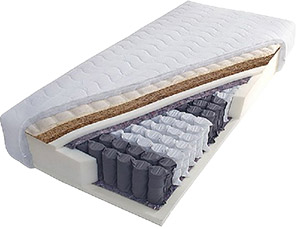

Pocketed coils are a component in many types of mattresses. In terms of support, this translates to a far superior system for your body. The coil goes down in an isolated fashion not affecting the glass at all, no motion transfer. Place a glass of water close to you on the bed and press down on a coil next to it. That one coil depresses, but nothing around it. Picture a bed of wrapped coils, now picture pressing down on one of them. They are not tied to each other but wrapped separately. Each coil is a cylinder instead of an hourglass for more stability, and each one is individually covered in cloth, so less squeaking. Pocketed coils are designed to combat the shortcomings of a traditional innerspring. Picture placing a glass of water on one side of the bed, and then pressing on a coil on the other, the indentation you make will affect the glass far across the bed, possibly causing it to spill. If a larger body part presses down on the springs, like your hip or your shoulder, the depression may extend far across the bed. This further causes a gap between parts of your body and the bed. When lying on a traditional innerspring mattress, pressure on one coil creates a hollow with all the coils surrounding it. What happens to the mattress is the surrounding springs, since they are all tied together, will all depress. Now picture pressing down in one place, you can hear the squeaking of the springs in your mind as you press down. You know what it looks like a bunch of metal coils all fastened together, each one an hourglass shape. Another benefit of pocketed coils is that they work extremely well to support specific pressure points on the body during sleep. Not only does this affect individual support, but it can affect a partner sleeping in the bed as well. With a traditional innerspring mattress, where the coils are all tied together and move in relation to each other, the fit is far less specific as pressure on one spring causes large sections of the mattress to depress. Pocketed coils offer a superior form of support because the coils respond to pressure individually, minimizing motion transfer and better contouring to the body. Every coil in the mattress is separately enclosed or wrapped in fabric, making them independent from one another. In a mattress with pocketed coils, each individual spring has its own pocket, hence the name.

More is better to a point, but after a certain coil density, more does not improve comfort. Mattresses also vary in the number of coils they have per square foot of the mattress. They are made of steel springs, and come in different shapes and thicknesses or gauges. Pocketed Coil Mattressīefore we delve into the differences in coil mattress construction, it helps to know just a little about coils. He went on to secure a Canadian patient on his Marshall coils and became the founder of the Marshall Mattress Company using his patented technology. Pocket coils, where the springs are individually wrapped or encased in a sleeve, were developed in the late 1800’s by James Marshall, a British inventor. In 1871, coils were first placed inside a mattress resulting in the innerspring mattress.

By 1865, these coils were used as a bed base, like a box spring, and patented.

In the late 1850’s, steel coils were invented as supports for furniture, in particular for chairs.


 0 kommentar(er)
0 kommentar(er)
